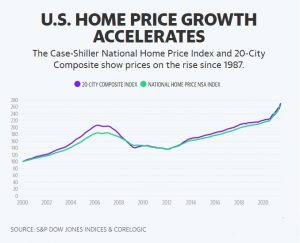
Ready to buy a home before the prices increase even more?
Home prices are currently up 20% year-over-year. The boom in prices was spurred by tight housing inventory, low interest rates, and household migration patterns during the pandemic. Millennials buying first time homes has only exacerbated the demand for houses.

Meanwhile investors with cash on their hands are trying to hedge against inflation by purchasing hard assets like real estate, thus driving prices higher. “The supply-demand picture that has been the basis for our call for a multi-year boom in home prices remains intact,” wrote Hatzius. “Housing inventories remain historically tight, and surveys of home buying intentions remain at healthy levels,” the note goes on. Numerous experts have predicted not to expect a housing crash like in 2008, given that the current market is so different. But home buyers may expect to see a leveling off in prices, especially if the Federal Reserve starts tapering its balance sheet and increasing interest rates in the future.
‘Homebuilders continue to face headwinds’
The supply of homes has increased modestly since the spring, though still well below pre-pandemic levels. Supply chain issues are slowing down efforts to get new homes on the market. “Homebuilders continue to face headwinds that were present before the pandemic — especially a lack of construction workers and a lack of available plots to build on — and the pandemic has exacerbated those problems,” said Hatzius. His team points to further delays from supply chain disruptions, lumber shortages, and now economy-wide labor shortages.
‘Relaxing the zoning rules and other regulatory constraints’
There is a solution to the national housing shortage which could help ease prices. “Economic research shows that relaxing the zoning rules and other regulatory constraints that have impeded homebuilding for decades would boost supply and lower prices and rents. But in practice, this has been difficult politically,” the note says. California recently banned single-family zoning statewide, making way for more multi-family dwellings. However, “nationwide changes seem unlikely for now, and limited state and local changes are only a partial step toward relieving the housing shortage,” writes Hatzius.



